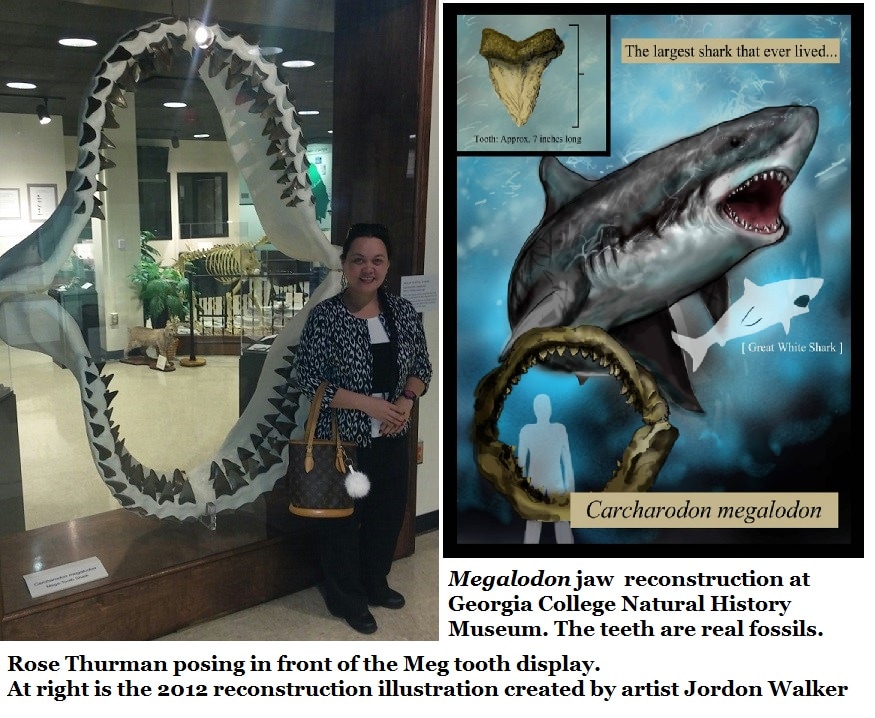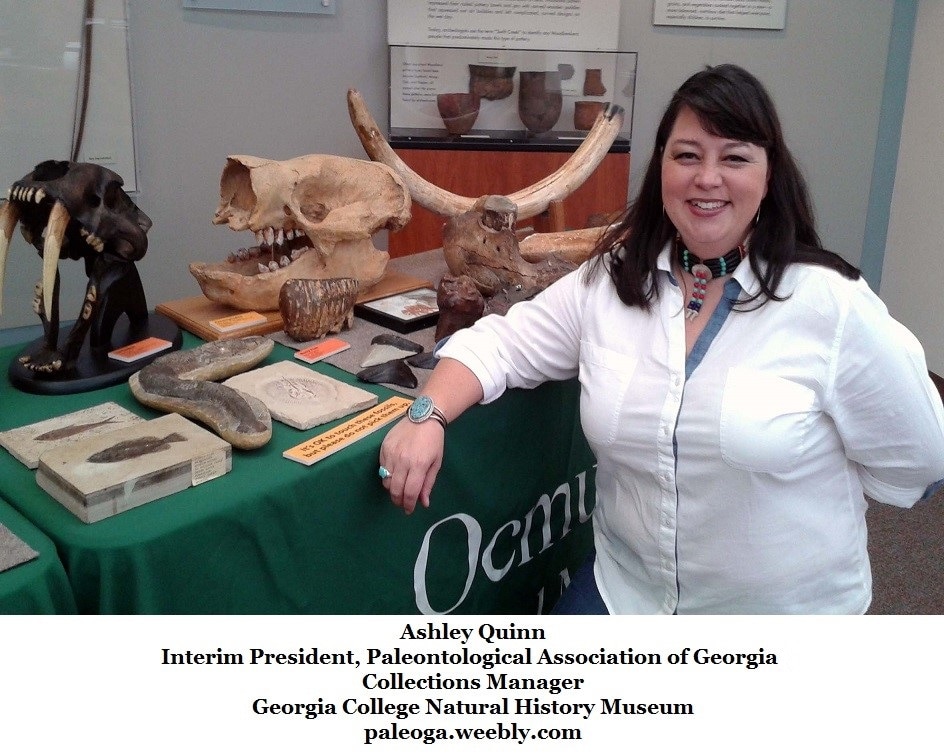26L: A Visit To:
Georgia College
Natural History Museum
Reported by Thomas Thurman
Visit their website;
www.gcsu.edu/nhm
Just last February, Ashley Quinn was kind enough to give my family a tour of the Georgia College Natural History Museum; our friend, Henry (Hank) Josey, joined us.

Let me say right now that Georgia College Natural History Museum is a jewel in Georgia’s Earth science education & research.
If you're a teacher needing a science field trip; contact Ashley, your students will wallow in WOW!
Ashley stands as the museum’s Natural History Collections Manager. You’ll also find her name on several pages of this website. She’s kindly advised me any number of times and I even spent a day in the field with her and Phil Manning a couple of years ago.
This museum isn’t a tourist center; but an active research institution. Visits are quiet, personal affairs. It's more like a library than a typical museum; a sacred place of history & science.
Some of the best Southeastern paleontologist, experts in their fields, made their names in the collections held in this museum. Researchers like Dr. Robert Chandler (Sections 13A, 18 & 19 of this website), Dr. Dennis Parmley (Sections 13A, 13B, 13D & 19), and Dr. Al Mead (Section 13A & 19) all helped establish Georgia College’s Natural History Museum. The specimens they collected and described, in numerous papers, all rest in the collection Ashley manages.
The research continues; Georgia College still creates and educates paleontologists.
Visiting
The museum is open to the public
& admission is free. (I love the words Free Admission!)
Monday through Friday; 8:00 am to 4:00 pm.
Location; Milledgeville, GA:
Museum and planetarium are located on the first floor of Herty Hall, on the corner of West Montgomery and North Wilkinson streets in Milledgeville, Georgia.
If you're a teacher needing a science field trip; contact Ashley, your students will wallow in WOW!
Ashley stands as the museum’s Natural History Collections Manager. You’ll also find her name on several pages of this website. She’s kindly advised me any number of times and I even spent a day in the field with her and Phil Manning a couple of years ago.
This museum isn’t a tourist center; but an active research institution. Visits are quiet, personal affairs. It's more like a library than a typical museum; a sacred place of history & science.
Some of the best Southeastern paleontologist, experts in their fields, made their names in the collections held in this museum. Researchers like Dr. Robert Chandler (Sections 13A, 18 & 19 of this website), Dr. Dennis Parmley (Sections 13A, 13B, 13D & 19), and Dr. Al Mead (Section 13A & 19) all helped establish Georgia College’s Natural History Museum. The specimens they collected and described, in numerous papers, all rest in the collection Ashley manages.
The research continues; Georgia College still creates and educates paleontologists.
Visiting
The museum is open to the public
& admission is free. (I love the words Free Admission!)
Monday through Friday; 8:00 am to 4:00 pm.
Location; Milledgeville, GA:
Museum and planetarium are located on the first floor of Herty Hall, on the corner of West Montgomery and North Wilkinson streets in Milledgeville, Georgia.
- Montgomery Street Entrance: Enter the ground floor of Herty Hall and follow the signs to the Museum/Planetarium. The Planetarium is located at the rear of the Natural History Museum.
- Wilkinson Street Entrance: Enter at the 2nd floor of Herty Hall and take the elevator to the 1st floor. Follow the signs to the Museum/Planetarium. The Planetarium is located at the rear of the Natural History Museum.
Layout
The museum's paleontology is essentially divided into two sections; a striking, though intimate display gallery and the research archives. Additionally, there is a fossil prep room (unavailable on the day we visited) and the nearby research offices.
Unlike the soaring galleries of other museums; the Georgia College Natural History Museum is a more personal experience. All the many displays of the gallery are near at hand and can be closely inspected.
Wonderful fossils aplenty fill the gallery; with a strong concentration of vertebrate material, but beautiful invertebrate fossils are also displayed. A fully articulated Smilodon (saber toothed cat) skeleton stands as sentinel; a big powerful reminder of a powerful cat.
The following slide show is from the museum's gallery;
The museum's paleontology is essentially divided into two sections; a striking, though intimate display gallery and the research archives. Additionally, there is a fossil prep room (unavailable on the day we visited) and the nearby research offices.
Unlike the soaring galleries of other museums; the Georgia College Natural History Museum is a more personal experience. All the many displays of the gallery are near at hand and can be closely inspected.
Wonderful fossils aplenty fill the gallery; with a strong concentration of vertebrate material, but beautiful invertebrate fossils are also displayed. A fully articulated Smilodon (saber toothed cat) skeleton stands as sentinel; a big powerful reminder of a powerful cat.
The following slide show is from the museum's gallery;
Visiting the gallery is a treat but it’s the archives which fascinates me. Where (with Ashley’s encouragement and watchful advice) we could respectfully handle the specimens. What an office Ashley has in the archives! Just behind her work station; 550 million years’ worth of fossils rest identified, organized and classified for reference and research purposes. We handled the remains of animals which lived before evolution had invented insects, enameled teeth or leaves. The world was a very strange place.
The museum holds 140,000+ specimens! There’s material covering vertebrate paleontology, invertebrate paleontology, paleobotany, ichthyology, mammalogy, entomology, herpetology, and conchology.
We happily pillaged the archives;
The museum holds 140,000+ specimens! There’s material covering vertebrate paleontology, invertebrate paleontology, paleobotany, ichthyology, mammalogy, entomology, herpetology, and conchology.
We happily pillaged the archives;
The museum opened in 2004 but the college began actively collecting specimens in 1983. There are specimens on hand which were originally collected during the 1800s. In 2008 the museum added a planetarium to further science education support.
Georgia hosts several fine natural history museums; but I freely admit that the facility at Georgia College is high on my personal favorite list.
In general, there are two types of such museums; both have fine galleries with dramatic displays of fossils and skeletons, but only one has research collections intended not only to educate, but advance the science.
This is mind-candy for the amateur and professional paleontologist. Dramatic displays of giant dinosaurs are great, but the science rests in the research collection.
In general, there are two types of such museums; both have fine galleries with dramatic displays of fossils and skeletons, but only one has research collections intended not only to educate, but advance the science.
This is mind-candy for the amateur and professional paleontologist. Dramatic displays of giant dinosaurs are great, but the science rests in the research collection.
Paleontological Association of Georgia
I should mention; in late January, Ashley Quinn was elected as Interim President for the newly founded Paleontological Association of Georgia; an alliance of amateurs, educators and professional paleontologists dedicated to promoting the science of paleontology in Georgia. This is above and beyond her duties at the museum.
Ashley is very active in earth science & earth science education.
I should mention; in late January, Ashley Quinn was elected as Interim President for the newly founded Paleontological Association of Georgia; an alliance of amateurs, educators and professional paleontologists dedicated to promoting the science of paleontology in Georgia. This is above and beyond her duties at the museum.
Ashley is very active in earth science & earth science education.
Thanks again Ashley for the tour, it was a great morning!
Collections
Georgia College Natural History Museum
(Borrowed from their website)
Vertebrate Paleontology (GCVP)
The vertebrate paleontology collection is one of the largest in the Southeast. Research collections include:
- North American Eocene/Oligocene vertebrates from Badlands National Park: over 7,000 specimens representing forty genera of mammals, including rare taxa like marsupials and insectivores and an extensive herpetofauna
- North American Late Eocene fossils from the Hardie Mine local fauna of central Georgia: including sharks, rays, bony fishes, snakes, turtles, birds, whales and land mammals
- North American Plio-Pleistocene faunas from the Santa Fe River of Florida: over 1,800 specimens representing 100 plant and vertebrate species including large terror birds, mammoths and glyptodons
- North American Pleistocene fauna from Clark Quarry near Brunswick, Georgia: including mammoth, bison, horse, birds, alligator, natricine snakes, bony and cartilaginous fish, arthropods, gastropods and bivalves.
- Smaller collections such as: Triassic vertebrates from Petrified National Forest, Cretaceous mammals and reptiles, Paleocene mammals, Eocene fish and several Late Pleistocene faunas are also available for study.
Invertebrate Paleontology (GCIP)
- The invertebrate paleontology collection consists of over 1,000 specimens of primarily North American Cambrian trilobites. Other specimens include trilobites from other localities around the world and other invertebrates.
Mammalogy (GCM)
- The mammalogy collection (approximately 1,500 specimens) was developed primarily for biomechanical comparisons between fossil and recent mammals. The strength of the collection therefore, is in its skeletal holdings.
- Representatives of all modern orders of mammals except Paucituberculata are included. Carnivores, cetaceans, primates, and ungulates are particularly well represented. Some of the more unusual specimens include complete skeletons of: African Lion; Leopard; Stellar Sea Lion; California Sea Lion; Florida Manatee; male and female Orangutans; Chimpanzee; Rock Hyrax; Giraffe; and White Rhinoceros.
- The collection also includes several hundred skins and skulls used primarily for teaching.
Herpetology (GCH)
- The herpetology collection consists of two types of holdings.
- The first is a teaching collection of fluid preserved specimens from Georgia (approximately 300-400 specimens). This collection is used in various vertebrate classes including Herpetology and Vertebrate Zoology.
- The second collection is an extensive skeletal collection (approximately 3,000 specimens) that was developed mainly for vertebrate paleontological comparative work.
- The strength of this collection is its taxonomic diversity. While most of the collection consists of North American taxa, representative families and genera from many other countries are also represented.
- The collection is extensively used in Oligocene through Holocene herpetological research.
Ornithology (GCO)
- The ornithology collection consists approximately 800 specimens of skins, skeletons, nests and eggs of primarily North American species, many that can be found in Georgia.
- Skins and skeletons are studied by students interested in bird systematics, fossil birds, avian biogeography, and morphology.
Ichthyology (GCI)
- GC’s fish collection consists of approximately 300-400 fluid preserved specimens from all regions of Georgia.
Entomology (GCEC)
- The entomology collection contains about 100,000 specimens.
- Practically every order of insect is represented and there is a strong teaching collection; however, the majority of specimens are aquatic Coleoptera, especially Dytiscidae.
- The GC entomology collection is one of the most complete in the southeast for dytiscid genera in the tribe Hydroporini, especially Heterosternuta and Neoporuswith specimens from Maine to Florida and west to Arkansas.
- There is also an extensive collection of Dytiscidae from Southern Africa and South America.


